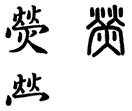Do Chinese Characters Tell
Us Something About Genesis?
Part 4 - The Fall
The Fall page is the third of five pages that attempt to relate the
forms
of Chinese characters to ideas from the Book of Genesis.
The first character on the Fall page is duo3, with the modern meaning "to hide". The
authors
say that this character consists of the elements "body", "is", and
"tree".
Nelson and Broadberry no longer support this interpretation.
Actually, the right side of the character, also pronounced duo3,
is simply the phonetic element. This element does not consist of "is" (nai3)
above "tree" (mu4), but is explained as follows.

Shu2, chu2. The jerky flapping of a short wing. Then, in
general,
any rhythmical and jerky motion. The derivatives of shu2 must
be carefully
distinguished from those of nai3 and ji1.

Duo3. The balancing of twigs and flowers. It is used as a
specificative [classifier] of flowers.
The second character on the Fall page is jian4, with the modern meaning "see, perceive;
visit".
The authors see this as a compound of "eye" and "walk", but it appears
to
be just a man with a big, over-emphasized eye. The spoken word has no
sense
of walking.

Jian4. To look. An eye (mu4) above a man (ren2).
The third character on the Fall page is shi4, with the modern meaning "look at;
vision".
The authors say that this is a compound of "god" and "to observe"
(meaning
the preceding character, jian4). However, in reality, the
element
that is supposed to represent "god", also pronounced shi4, is
the
phonetic element, and jian4 is the semantic element. Nelson and
Broadberry
no longer support this interpretation.
The fourth character on the Fall page is guo2, with the modern meaning "fruit; result".
The
authors say that this character has the part "garden" on top of a
"tree".
This seems like an odd juxtaposition. Wieger has a different
interpretation.

Guo2. The fruit of a tree, represented by tian2 on top
of mu4.
The fifth, sixth, and seventh characters on the Fall page are variants
of
the morpheme luo3, with the modern meaning "naked". The authors
list
these as compound indicative characters, but guo2, fruit, is
the phonetic
element in all of them.
The eighth character on the Fall page is gu2, with the modern meaning "ancient, old".
The
authors are correct in interpreting it as being composed of "ten" and
"mouth",
but then go overboard in interpreting the "ten" as referring to
"fingers",
and the "mouth" to "eating", with no explanation of how that might
produce
the meaning "ancient". Nelson and Broadberry no longer support this
interpretation.
Here is Wieger's explanation:

Gu2. That which has passed through ten mouths, i.e. a tradition
dating
back ten generations.
The ninth character on the Fall page is ku3, with the modern meaning "bitter; sorrow,
suffering".
The authors interpret it as a compound indicative character, but the gu2
portion is simply the phonetic element. Nelson and Broadberry no longer
support
this interpretation.
The tenth character on the Fall page is chu3, the name of an ancient Chinese state.
The
authors interpret this as "two trees" above "piece". Nelson and
Broadberry
no longer support this interpretation.
The first problem is that it doesn't mean "sorrow" on it's own. It
has the additional meaning of "sharp, keen; clear, distinct". The
second is that
the lower part of the character is the phonetic element, pronounced shu2,
not the character pi3 ("a rolled up piece of cloth") that they
took it to be. The third is that it means "foot in motion, to turn".
Here's Wieger:

Chu3. A country planted with trees; shu2 is phonetic.
The eleventh "character" on the Fall page is not a
single
character at all. It is a two-character phrase, ku3chu3, that
can
be found in any dictionary. It means "distress; suffering and pain".
The twelfth character on the Fall page is yu2, with the modern meaning "in, on, at, by;
than".
The authors state that it means "offender", but I don't know where they
came
up with that interpretation.
The thirteenth character on the Fall page is xing2, with the modern meaning "to punish;
punishment;
a law". The authors claim that it consists of two "offenders" and
"knife".
Nelson and Broadberry no longer support this interpretation.
There are no offenders there. The left-hand element was originally jing3,
with the modern meaning "a well", but originally "designed to represent
eight
square lots of fields, divided among eight families, reserving the
middle
square for public use, and digging a well in it. The well is
represented by
a dot."

Xing2. Legal punishment (by a sword), which was arbitrarily
written
by the scribes as in the lower right.
The fourteenth character on the Fall page is jing1, with the modern meaning "thorn,
bramble".
The authors interpret it as a compound of "punishment" and "weeds", but
the
"punishment" portion is simply the phonetic element. Nelson and
Broadberry
no longer support this interpretation.
The fifteenth and sixteenth characters on the Fall page are
interpreted
by the authors as if the upper portion of each, two "fires" and
"cover",
were used for the meaning "glorious". Nelson and Broadberry no longer
support
this interpretation.
Actually, the upper portion is the phonetic element in both cases.

Ying2. The light (huo3 fire) of many lamps in a room.
This
character forms a large group of compounds in which the huo3 at
the
bottom gives room to the radical.
The Creation The Garden of Eden The Flood The Tower of Babel
Back to the Chinese Characters and Genesis
Home Page
 Languages Page
Languages Page
 Back to RaccoonBend.com Home
Page
Back to RaccoonBend.com Home
Page









![]() Back to RaccoonBend.com Home
Page
Back to RaccoonBend.com Home
Page